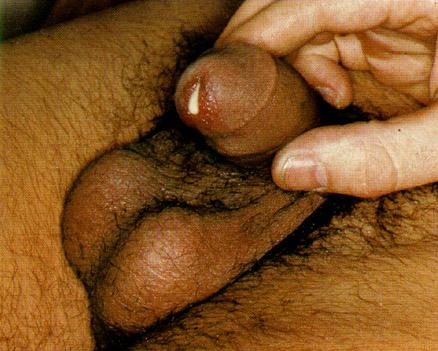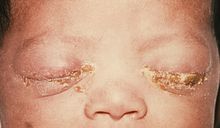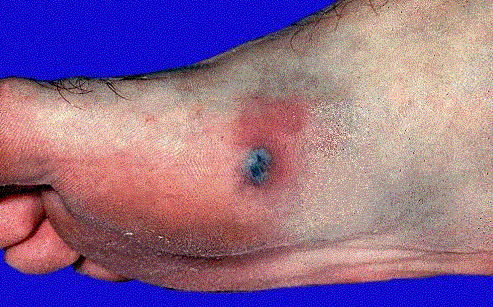Gonorrhea history and symptoms
|
Gonorrhea Microchapters |
|
Diagnosis |
|
Treatment |
|
Case Studies |
|
Gonorrhea history and symptoms On the Web |
|
American Roentgen Ray Society Images of Gonorrhea history and symptoms |
|
Risk calculators and risk factors for Gonorrhea history and symptoms |
Editor-In-Chief: C. Michael Gibson, M.S., M.D. [1]; Associate Editor(s)-in-Chief: Sara Mehrsefat, M.D. [2], Priyamvada Singh, MBBS [3]
Overview
It is critical to obtain a detailed and thorough sexual history from the patient. Specific areas of focus when obtaining a history from a patient include number and type of sexual partners, contraception use, and previous history of sexually transmitted diseases. The majority of women with gonorrhea are asymptomatic, while others have vaginal discharge, lower abdominal pain, or pain during sexual intercourse. Common symptom of gonococcal infection in men include urethritis, which is associated with burning with urination and discharge from the penis. Either sex may also acquire gonorrhea of the throat from performing oral sex on an infected partner, usually a male partner. Such infection is asymptomatic in 90% of cases, and produces a sore throat in the remaining 10%. The incubation period is 2 to 14 days, with most of these symptoms occurring between 4–6 days after being infected.[1][2][3][4] Rarely, gonorrhea may cause skin lesions and joint infection (pain and swelling in the joints) after traveling through the blood stream. Very rarely, it may settle in the heart, causing endocarditis, or in the spinal column, causing meningitis.[5]
History and Symptoms
History
It is critical to obtain a detailed and thorough sexual history from the patient. In patients with suspected sexually transmitted diseases, the following aspects of the patient's history should be sought:[1][2][3]
- Number and type of sexual partners
- Previous history of gonococcal infection or other sexually transmitted diseases
- Past history of similar symptoms or STDs in patient and current or past partners
- Type of contraception used
- History of sexual assault
- Reproductive history
- Details of parity including any history of ectopic pregnancies
- Timing of the last menstrual period
- Assessing the possibility of pregnancy
Symptoms
Common urogenital and extragenital Infection
- Between 30–60% of women with gonorrhea are asymptomatic or have subclinical disease.[6]
- The incubation time varies from 2 to 14 days with most symptoms occurring between days 2 and 5 after being infected from an infected partner.
- A small number of people may be asymptomatic for up to a year. They may be completely unaware that they have caught the disease, and therefore do not seek treatment. This increases the risk of complications and the chances of passing the infection on to another person.
Common symptoms of urogenital and extragenital gonococcal Infection may include the following:[1][2][3][4][7][8]
| Type of Gonococcal Infection | Symptoms | Images[9][10] |
|---|---|---|
| Male Genitourinary |
| |
| Female Genitourinary |
|
|
| Gonococcal proctitis (Rectal) | ||
| Gonococcal pharyngitis |
|
|
| Ophthalmia neonatorum |
|
|
Disseminated gonococcal infection
Symptoms of disseminated gonorrheal infection may include the following:[11][12][5]
| Type of Disseminated gonorrheal infection | Symptoms | Images[10][13] |
|---|---|---|
| Arthritis Dermatitis Syndrome |
|
|
| Septic arthritis |
|
|
| Gonorrhea Meningitis |
|
|
| Gonorrhea Endocarditis |
|
|
References
- ↑ 1.0 1.1 1.2 Workowski KA, Bolan GA, Centers for Disease Control and Prevention (2015). "Sexually transmitted diseases treatment guidelines, 2015". MMWR Recomm Rep. 64 (RR-03): 1–137. PMID 26042815.
- ↑ 2.0 2.1 2.2 Sherrard J, Barlow D (1996). "Gonorrhoea in men: clinical and diagnostic aspects". Genitourin Med. 72 (6): 422–6. PMC 1195730. PMID 9038638.
- ↑ 3.0 3.1 3.2 Barlow D, Phillips I (1978). "Gonorrhoea in women. Diagnostic, clinical, and laboratory aspects". Lancet. 1 (8067): 761–4. PMID 76760.
- ↑ 4.0 4.1 Osborne NG, Grubin L (1979). "Colonization of the pharynx with Neisseria gonorrhoeae: experience in a clinic for sexually transmitted diseases". Sex Transm Dis. 6 (4): 253–6. PMID 119330.
- ↑ 5.0 5.1 Rice PA (2005). "Gonococcal arthritis (disseminated gonococcal infection)". Infect Dis Clin North Am. 19 (4): 853–61. doi:10.1016/j.idc.2005.07.003. PMID 16297736.
- ↑ van Duynhoven YT (1999). "The epidemiology of Neisseria gonorrhoeae in Europe". Microbes Infect. 1 (6): 455–64. PMID 10602678.
- ↑ Stansfield VA (1980). "Diagnosis and management of anorectal gonorrhoea in women". Br J Vener Dis. 56 (5): 319–21. PMC 1045815. PMID 7427703.
- ↑ Kraus SJ (1Link title979). "Incidence and therapy of gonococcal pharyngitis". Sex Transm Dis. 6 (2 Suppl): 143–7. PMID 386537. Check date values in:
|year=(help) - ↑ STD Gonorrhea Infection Gallery http://www.std-gov.org/std_picture/gonorrhea_w.htm Accessed on September 22, 2016
- ↑ 10.0 10.1 Centers for Disease Control and Prevention. Public Health Image Library (PHIL) http://phil.cdc.gov/phil/details.asp Accessed on September 22, 2016
- ↑ Bleich AT, Sheffield JS, Wendel GD, Sigman A, Cunningham FG (2012). "Disseminated gonococcal infection in women". Obstet Gynecol. 119 (3): 597–602. doi:10.1097/AOG.0b013e318244eda9. PMID 22353959.
- ↑ O'Brien JP, Goldenberg DL, Rice PA (1983). "Disseminated gonococcal infection: a prospective analysis of 49 patients and a review of pathophysiology and immune mechanisms". Medicine (Baltimore). 62 (6): 395–406. PMID 6415361.
- ↑ STD Gonorrhea Infection Gallery http://www.std-gov.org/std_picture/gonorrhea_w.htm Accessed on September 22, 2016



